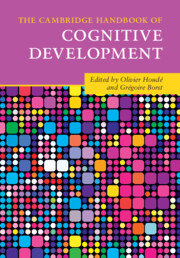Book contents
- The Cambridge Handbook of Cognitive Development
- The Cambridge Handbook of Cognitive Development
- Copyright page
- Contents
- Figures
- Tables
- Contributors
- Introduction
- Part I Neurobiological Constraints and Laws of Cognitive Development
- Part II Fundamentals of Cognitive Development from Infancy to Adolescence and Young Adulthood
- Introduction
- Subpart II.1 Infancy: The Roots of Human Thinking
- 7 Differences between Humans, Great Apes and Monkeys in Cognition, Communication, Language and Morality
- 8 Infants’ Physical Reasoning and the Cognitive Architecture that Supports It
- 9 Infant Categorization
- 10 Foundational Considerations
- 11 How Sophisticated Is Infants’ Theory of Mind?
- 12 Social Cognition and Moral Evaluation in Early Human Childhood
- 13 Scientific Thinking and Reasoning in Infants and Young Children
- 14 Computational Approaches to Cognitive Development
- Subpart II.2 Childhood and Adolescence: The Development of Human Thinking
- Part III Education and School-Learning Domains
- Index
- Plate Section (PDF Only)
- References
14 - Computational Approaches to Cognitive Development
Bayesian and Artificial-Neural-Network Models
from Subpart II.1 - Infancy: The Roots of Human Thinking
Published online by Cambridge University Press: 24 February 2022
- The Cambridge Handbook of Cognitive Development
- The Cambridge Handbook of Cognitive Development
- Copyright page
- Contents
- Figures
- Tables
- Contributors
- Introduction
- Part I Neurobiological Constraints and Laws of Cognitive Development
- Part II Fundamentals of Cognitive Development from Infancy to Adolescence and Young Adulthood
- Introduction
- Subpart II.1 Infancy: The Roots of Human Thinking
- 7 Differences between Humans, Great Apes and Monkeys in Cognition, Communication, Language and Morality
- 8 Infants’ Physical Reasoning and the Cognitive Architecture that Supports It
- 9 Infant Categorization
- 10 Foundational Considerations
- 11 How Sophisticated Is Infants’ Theory of Mind?
- 12 Social Cognition and Moral Evaluation in Early Human Childhood
- 13 Scientific Thinking and Reasoning in Infants and Young Children
- 14 Computational Approaches to Cognitive Development
- Subpart II.2 Childhood and Adolescence: The Development of Human Thinking
- Part III Education and School-Learning Domains
- Index
- Plate Section (PDF Only)
- References
Summary
As in other sciences, formal modeling and simulation have assumed an important role in organizing and explaining cognitive development and providing a more unified account of its computational underpinnings. This chapter reviews research using two of the most influential approaches to such modeling: Bayesian and artificial neural networks. The techniques are explained for a general audience and concrete examples are described, providing both an in-depth and broad coverage of the literature.
- Type
- Chapter
- Information
- The Cambridge Handbook of Cognitive Development , pp. 318 - 338Publisher: Cambridge University PressPrint publication year: 2022



